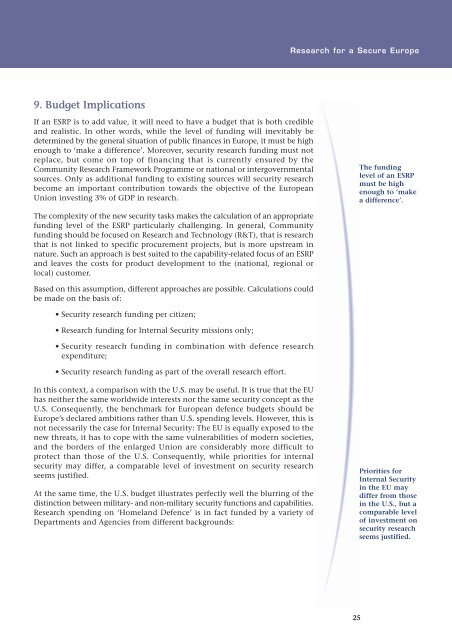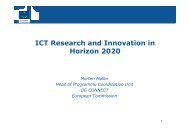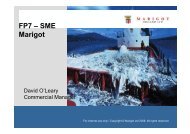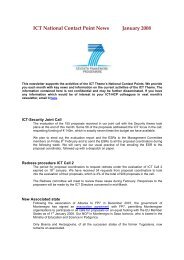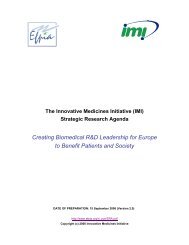Research for a Secure Europe - European Commission - Europa
Research for a Secure Europe - European Commission - Europa
Research for a Secure Europe - European Commission - Europa
Create successful ePaper yourself
Turn your PDF publications into a flip-book with our unique Google optimized e-Paper software.
<strong>Research</strong> <strong>for</strong> a <strong>Secure</strong> <strong>Europe</strong><br />
9. Budget Implications<br />
If an ESRP is to add value, it will need to have a budget that is both credible<br />
and realistic. In other words, while the level of funding will inevitably be<br />
determined by the general situation of public finances in <strong>Europe</strong>, it must be high<br />
enough to ‘make a difference’. Moreover, security research funding must not<br />
replace, but come on top of financing that is currently ensured by the<br />
Community <strong>Research</strong> Framework Programme or national or intergovernmental<br />
sources. Only as additional funding to existing sources will security research<br />
become an important contribution towards the objective of the <strong>Europe</strong>an<br />
Union investing 3% of GDP in research.<br />
The funding<br />
level of an ESRP<br />
must be high<br />
enough to ‘make<br />
a difference’.<br />
The complexity of the new security tasks makes the calculation of an appropriate<br />
funding level of the ESRP particularly challenging. In general, Community<br />
funding should be focused on <strong>Research</strong> and Technology (R&T), that is research<br />
that is not linked to specific procurement projects, but is more upstream in<br />
nature. Such an approach is best suited to the capability-related focus of an ESRP<br />
and leaves the costs <strong>for</strong> product development to the (national, regional or<br />
local) customer.<br />
Based on this assumption, different approaches are possible. Calculations could<br />
be made on the basis of:<br />
• Security research funding per citizen;<br />
• <strong>Research</strong> funding <strong>for</strong> Internal Security missions only;<br />
• Security research funding in combination with defence research<br />
expenditure;<br />
• Security research funding as part of the overall research ef<strong>for</strong>t.<br />
In this context, a comparison with the U.S. may be useful. It is true that the EU<br />
has neither the same worldwide interests nor the same security concept as the<br />
U.S. Consequently, the benchmark <strong>for</strong> <strong>Europe</strong>an defence budgets should be<br />
<strong>Europe</strong>’s declared ambitions rather than U.S. spending levels. However, this is<br />
not necessarily the case <strong>for</strong> Internal Security: The EU is equally exposed to the<br />
new threats, it has to cope with the same vulnerabilities of modern societies,<br />
and the borders of the enlarged Union are considerably more difficult to<br />
protect than those of the U.S. Consequently, while priorities <strong>for</strong> internal<br />
security may differ, a comparable level of investment on security research<br />
seems justified.<br />
At the same time, the U.S. budget illustrates perfectly well the blurring of the<br />
distinction between military- and non-military security functions and capabilities.<br />
<strong>Research</strong> spending on ‘Homeland Defence’ is in fact funded by a variety of<br />
Departments and Agencies from different backgrounds:<br />
Priorities <strong>for</strong><br />
Internal Security<br />
in the EU may<br />
differ from those<br />
in the U.S., but a<br />
comparable level<br />
of investment on<br />
security research<br />
seems justified.<br />
25


